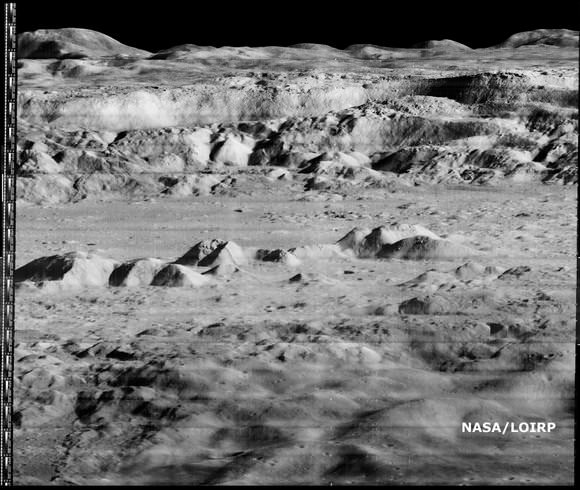[/caption]
More imaging goodness is now available from the folks at the Lunar Orbiter Image Recovery Project
(LOIRP)
, a cooperative effort between NASA and private business to give new life to some of the first ever close-up images of the Moon. When this image was originally released in November of 1966, it was called the "Image of the Century." Taken by the Lunar Orbiter 2 spacecraft, 45.7 kilometers (28.4 miles) above the Moon's surface, the image showed details of the interior of the crater
Copernicus
. Now, through the work of (LOIRP), the image has been remastered to show even more detail and the dramatic landscape within the crater.
At the time this image was originally released most views of the lunar surface involved looking straight down. Little, if any, sense of the true elevation of lunar surface features was usually available. This photo changed that perception by showing the Moon to be a world with tremendous topography - some of it Earth-like, much of it decidedly un-earth-like.
Time Magazine wrote about the image in December of 1966, (
"A New Look at Copernicus")
:
"Except for the black sky in the background, the photograph might have been mistaken for a composite of the scenic grandeur of Grand Canyon and the barren desolation of the Badlands of South Dakota. But when it was flashed unexpectedly onto a screen at a meeting of the American Institute of Aeronautics and Astronautics in Boston last week, sophisticated space scientists and engineers recognized the terrain immediately. It was a spectacular close up shot of lunar landscape. That photograph of the moon's Crater of Copernicus, said NASA Scientist Martin Swetnick, is "one of the great pictures of the century."
NASA and a few private space business leaders spent a quarter million dollars rescuing the historic photos from early NASA lunar robotic probes and restoring them in an abandoned McDonald's at Moffet Field, in California. This project uses the original analog data tapes and restored tape drives to digitize original Lunar Orbiter project imagery. Utilizing computer technology unavailable at the time the images were originally taken, LOIRP has been able to produce images which greatly exceed the resolution of the images as they were first seen in 1966 and 1967.
The first image released by the LOIRP,
the famous "earthrise image", was made public in November 2008, and they hope to be releasing more "new" images soon.
The LOIRP, funded by NASA's Exploration Mission Systems Directorate and NASA's Innovative Partnership's Program, with support from Odyssey Moon, Skycorp Inc., SpaceRef Interactive Inc., ACES, and the NASA Lunar Science Institute.
For more information about LOIRP and to see more images,
check out their website.
 Universe Today
Universe Today
